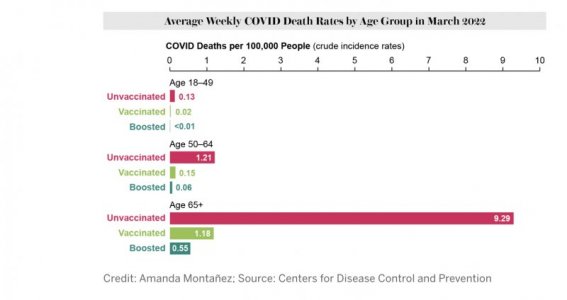Two things went wrong with that.
The mRna caused the immune system to go into over-drive, and it leeched through blood vessels, bringing the spike protein with it. The most frequent side-effect of that was blood clots and embolisms.
In hundreds of thousands of people who were vaccinated, those side-effects ranged from bad to deadly.
Maybe.....not. #1, don't forget studies of COVID (and its variants) aftereffects AND the comparable statistics between the vaxxed who fall ill of disease vs the unvaxxed who fall ill of the identical disease, are still ongoing. IOW, if you take a large enough group, there will be people who will be diagnosed with the disease whether or not they received a COVID vaccine.
Then the question becomes,
did the vaccines* enable a milder outcome,
or set off a more severe, possibly fatal, result? As of March 2022 UNMC Nebraska (one of the highest-rated regional hospitals in the US) lists 57% of the world's population as vaxxed, or 11 BILLION people.
* don't forget there are multiple brands of COVID vaccines, so statistics will vary.
Some excerpts from their study:
- Viral infections, like COVID-19, can cause myocarditis. If COVID-19 causes you to seek care, your risk of myocarditis rises. The CDC reports COVID-19 patients had 16 times higher myocarditis risk compared to patients without COVID-19.
-150 myocarditis cases per 100K patients who caught COVID
- 9 myocarditis cases per 100K patients w/o COVID
Thus, if you don't get vaxxed, maybe you'll be fine. But if you DO develop COVID, you have a 16x better chance of developing heart-related issues. The conclusion was: "The
risk of damage from the virus is much greater than the risk of damage from the vaccines. These vaccines will protect you from heart problems due to COVID-19 infection."
- Clots: The UNMC report summarized a very technical study published in The Lancet, the premier peer-reviewed global journal. There are 2 types referenced: cerebral venous thrombosis (CVT; brain clots) and portal vein thrombosis (PVT; clots elsewhere in the body).
" In a large electronic health records network, the absolute incidence of CVT and PVT in the 14 days after COVID-19 diagnosis was 42.8 cases and 392.3 cases per million patients respectively. The incidence rapidly decreased in the following weeks, compatible with a causal link between COVID-19 and those thrombotic events.
The incidence of CVT and PVT after COVID-19 is substantially greater than in the matched control cohorts (the unvaxxed group). The incidence of CVT after a diagnosis of COVID-19 is also substantially greater than the expected incidence in the general population in the USA, estimated to be between 0.53 and 0.77 per million people in any 2-week period and the rate is significantly higher than the highest of these estimates. "
The Lancet paper notes that the percentage of reported clotting problems was higher with the Oxford-AstraZeneca vaccine. The UNMC study reported that the Johnson & Johnson vaccine, which came to the US market last due to its use of traditional (non-mRNA) process, has had the most serious side effects, specifically:
- Blood clots in the brain, abdomen and legs, along with low levels of platelets – the blood cells that help your body stop bleeding – have occurred in a small number of people who have received the Johnson & Johnson COVID-19 vaccine. This outcome is very rare. Called thrombosis with thrombocytopenia syndrome (TTS), this occurs in 3.8 cases per million people who receive the Johnson & Johnson vaccine. This means 0.00038% of people who get vaccinated with J&J experience TTS. Approximately 19 million people received the J&J vaccine before it was pulled off the market, when it was determined women between ages 18-48 were at high risk for rare blood clots after receiving the J&J shot.
The UNMC Nebraska report is here:
COVID-19 vaccine statistics: Rare side effects

